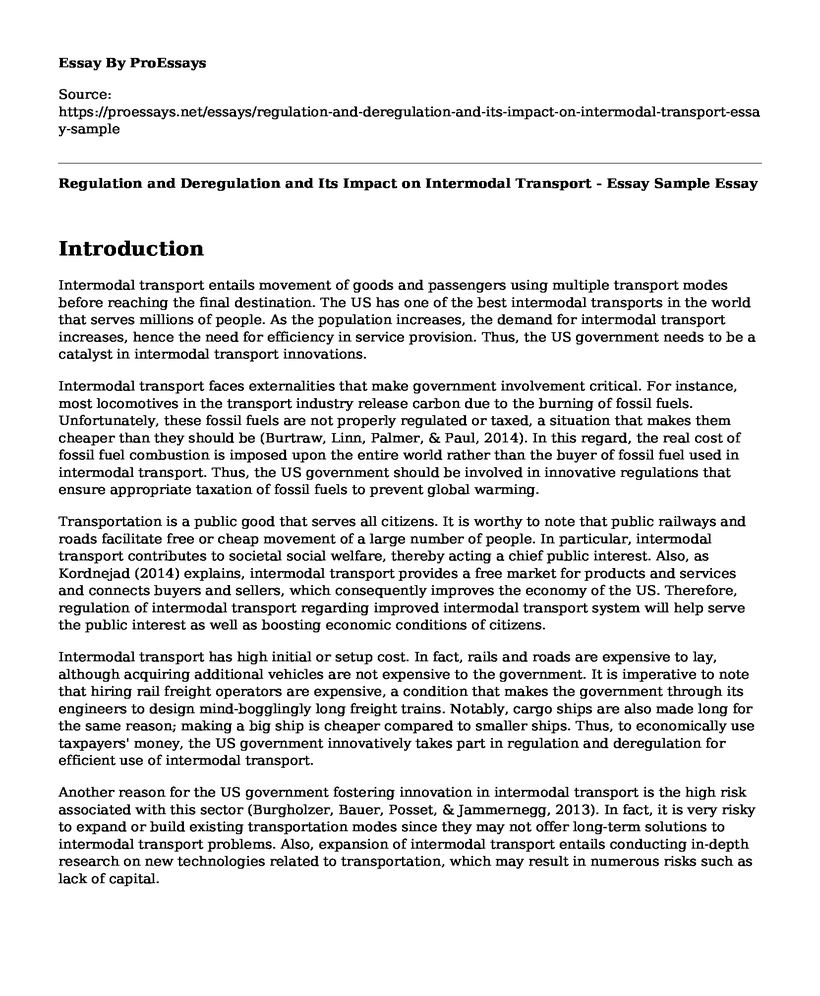Introduction
Intermodal transport entails movement of goods and passengers using multiple transport modes before reaching the final destination. The US has one of the best intermodal transports in the world that serves millions of people. As the population increases, the demand for intermodal transport increases, hence the need for efficiency in service provision. Thus, the US government needs to be a catalyst in intermodal transport innovations.
Intermodal transport faces externalities that make government involvement critical. For instance, most locomotives in the transport industry release carbon due to the burning of fossil fuels. Unfortunately, these fossil fuels are not properly regulated or taxed, a situation that makes them cheaper than they should be (Burtraw, Linn, Palmer, & Paul, 2014). In this regard, the real cost of fossil fuel combustion is imposed upon the entire world rather than the buyer of fossil fuel used in intermodal transport. Thus, the US government should be involved in innovative regulations that ensure appropriate taxation of fossil fuels to prevent global warming.
Transportation is a public good that serves all citizens. It is worthy to note that public railways and roads facilitate free or cheap movement of a large number of people. In particular, intermodal transport contributes to societal social welfare, thereby acting a chief public interest. Also, as Kordnejad (2014) explains, intermodal transport provides a free market for products and services and connects buyers and sellers, which consequently improves the economy of the US. Therefore, regulation of intermodal transport regarding improved intermodal transport system will help serve the public interest as well as boosting economic conditions of citizens.
Intermodal transport has high initial or setup cost. In fact, rails and roads are expensive to lay, although acquiring additional vehicles are not expensive to the government. It is imperative to note that hiring rail freight operators are expensive, a condition that makes the government through its engineers to design mind-bogglingly long freight trains. Notably, cargo ships are also made long for the same reason; making a big ship is cheaper compared to smaller ships. Thus, to economically use taxpayers' money, the US government innovatively takes part in regulation and deregulation for efficient use of intermodal transport.
Another reason for the US government fostering innovation in intermodal transport is the high risk associated with this sector (Burgholzer, Bauer, Posset, & Jammernegg, 2013). In fact, it is very risky to expand or build existing transportation modes since they may not offer long-term solutions to intermodal transport problems. Also, expansion of intermodal transport entails conducting in-depth research on new technologies related to transportation, which may result in numerous risks such as lack of capital.
Historical Examples
As an illustration, the US government was a catalyst in nuclear power research which brought successes since nuclear power has enormous risks, high initial cost, and externalities. This led to proper research that led to the setup of a nuclear power plant. Another project that involved government intervention was the development of military technology which falls under both public and private research (Block & Keller, 2015).
Conclusion
Intermodal transport is an expensive utility with a lot of externalities. Moreover, it serves a large number of people who use it for various reasons. Thus, the private sector is unable to provide innovations that can improve it. In this regard, the US government should take the lead in developing strategic innovations that ensure that intermodal transport is efficient to propel its economy.
References
Block, F. L., & Keller, M. R. (2015). State of innovation: the US government's role in technology development. Routledge.
Burgholzer, W., Bauer, G., Posset, M., & Jammernegg, W. (2013). Analysing the impact of disruptions in intermodal transport networks: A micro simulation-based model. Decision Support Systems, 54(4), 1580-1586.
Burtraw, D., Linn, J., Palmer, K., & Paul, A. (2014). The costs and consequences of clean air act regulation of CO2 from power plants. American Economic Review, 104(5), 557-62.
Kordnejad, B. (2014). Intermodal transport cost model and intermodal distribution in urban freight. Procedia-Social and Behavioral Sciences, 125, 358-372.
Cite this page
Regulation and Deregulation and Its Impact on Intermodal Transport - Essay Sample. (2022, Jun 13). Retrieved from https://proessays.net/essays/regulation-and-deregulation-and-its-impact-on-intermodal-transport-essay-sample
If you are the original author of this essay and no longer wish to have it published on the ProEssays website, please click below to request its removal:
- Imperialism in Conrad's Heart of Darkness and Its Relevance Today
- Defence Policy Paper Example
- Essay Example on Torture in Indonesian Justice System: Stoning to Death & Human Rights
- Union Discriminates Female Police Inspector, Chief Massey Alerts Colleagues - Essay Sample
- Exploring Socialism's Impact on Humanity: A Family Story - Essay Sample
- Essay Sample on School-Going Children's Safety: Traffic Lights to Control Motorists
- Essay on Modes of Production Determine Social Relations: Marxist Theory of Historical Materialism







